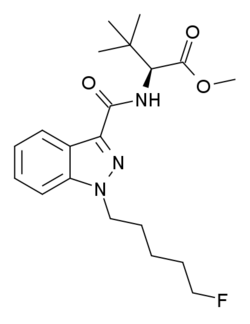Chemistry:5F-ADB
 | |
| Legal status | |
|---|---|
| Legal status |
|
| Identifiers | |
| |
| CAS Number | |
| PubChem CID | |
| ChemSpider | |
| UNII |
|
| KEGG | |
| Chemical and physical data | |
| Formula | C20H28FN3O3 |
| Molar mass | 377.460 g·mol−1 |
| 3D model (JSmol) | |
| |
| |
5F-ADB (also known as MDMB-5F-PINACA[1] and 5F-MDMB-PINACA) is an indazole-based synthetic cannabinoid from the indazole-3-carboxamide family, which has been used as an active ingredient in synthetic cannabis products and has been sold online as a designer drug.[2][3] 5F-ADB is a potent agonist of the CB1 receptor,[4] though it is unclear whether it is selective for this target. 5F-ADB was first identified in November 2014 from post-mortem samples taken from an individual who had died after using a product containing this substance. Subsequent testing identified 5F-ADB to have been present in a total of ten people who had died from unexplained drug overdoses in Japan between September 2014 and December 2014. 5F-ADB is believed to be extremely potent based on the very low levels detected in tissue samples, and appears to be significantly more toxic than earlier synthetic cannabinoid drugs that had previously been sold.[5]
In 2018, 5F-ADB was the most common synthetic cannabinoid to be identified in Drug Enforcement Administration seizures.[6] 5F-ADB was also identified in cannabidiol (CBD) products from a US-based CBD manufacturer in 2018.[7]
Deaths
5F-MDMB-PINACA has been associated with 25 deaths in Europe between 2015 and 2017.[8]
Legal status
In the United States, 5F-ADB is a schedule I controlled substance.[9]
5F-ADB was added to the Japanese banned drug list in December 2014.
See also
- 5F-AB-PINACA
- 5F-AMB
- 5F-APINACA
- AB-CHMINACA
- AB-FUBINACA
- AB-CHFUPYCA
- AB-PINACA
- ADB-BINACA
- ADB-CHMINACA
- ADB-FUBINACA
- ADB-PINACA
- ADBICA
- APICA
- APINACA
- MDMB-CHMICA
- MDMB-FUBINACA
- PX-3
References
- ↑ Pulver, Benedikt; Fischmann, Svenja; Gallegos, Ana; Christie, Rachel (March 2023). "EMCDDA framework and practical guidance for naming synthetic cannabinoids". Drug Testing and Analysis 15 (3): 255–276. doi:10.1002/dta.3403.
- ↑ "Identification and analytical characteristics of synthetic cannabinoids with an indazole-3-carboxamide structure bearing a N-1-methoxycarbonylalkyl group". Analytical and Bioanalytical Chemistry 407 (21): 6301–6315. August 2015. doi:10.1007/s00216-015-8612-7. PMID 25893797.
- ↑ "Detection of AP-237 and synthetic cannabinoids on an infused letter sent to a German prisoner". Drug Testing and Analysis 14 (10): 1779–1784. October 2022. doi:10.1002/dta.3351. PMID 35918775.
- ↑ "Pharmacology of Valinate and tert-Leucinate Synthetic Cannabinoids 5F-AMBICA, 5F-AMB, 5F-ADB, AMB-FUBINACA, MDMB-FUBINACA, MDMB-CHMICA, and Their Analogues". ACS Chemical Neuroscience 7 (9): 1241–1254. September 2016. doi:10.1021/acschemneuro.6b00137. PMID 27421060.
- ↑ "Identification and quantitation of 5-fluoro-ADB, one of the most dangerous synthetic cannabinoids, in the stomach contents and solid tissues of a human cadaver and in some herbal products". Forensic Toxicology 33: 112–121. 2014. doi:10.1007/s11419-014-0259-0.
- ↑ "Emerging Threat Report: Annual 2018". Special Testing and Research Laboratory, Drug Enforcement Administration. https://ndews.umd.edu/sites/ndews.umd.edu/files/Emerging-Threat-Report-2018-Annual.pdf.
- ↑ "The unexpected identification of the cannabimimetic, 5F-ADB, and dextromethorphan in commercially available cannabidiol e-liquids". Forensic Science International 294: e25–e27. January 2019. doi:10.1016/j.forsciint.2018.10.019. PMID 30442388.
- ↑ European Monitoring Centre for Drugs and Drug Addiction; Europol (2017). 5F-MDMB-PINACA (Report). Luxembourg: Publications Office of the European Union. doi:10.2810/210307. https://www.emcdda.europa.eu/system/files/publications/5483/2017.4963_TDAS17003ENN_PDFWEB.pdf.
- ↑ "Schedules of Controlled Substances: Temporary Placement of Six Synthetic Cannabinoids (5F-ADB, 5F-AMB, 5F-APINACA, ADB-FUBINACA, MDMB-CHMICA and MDMB-FUBINACA) Into Schedule I". Drug Enforcement Administration. https://www.deadiversion.usdoj.gov/fed_regs/rules/2016/fr1221.htm.
 |

